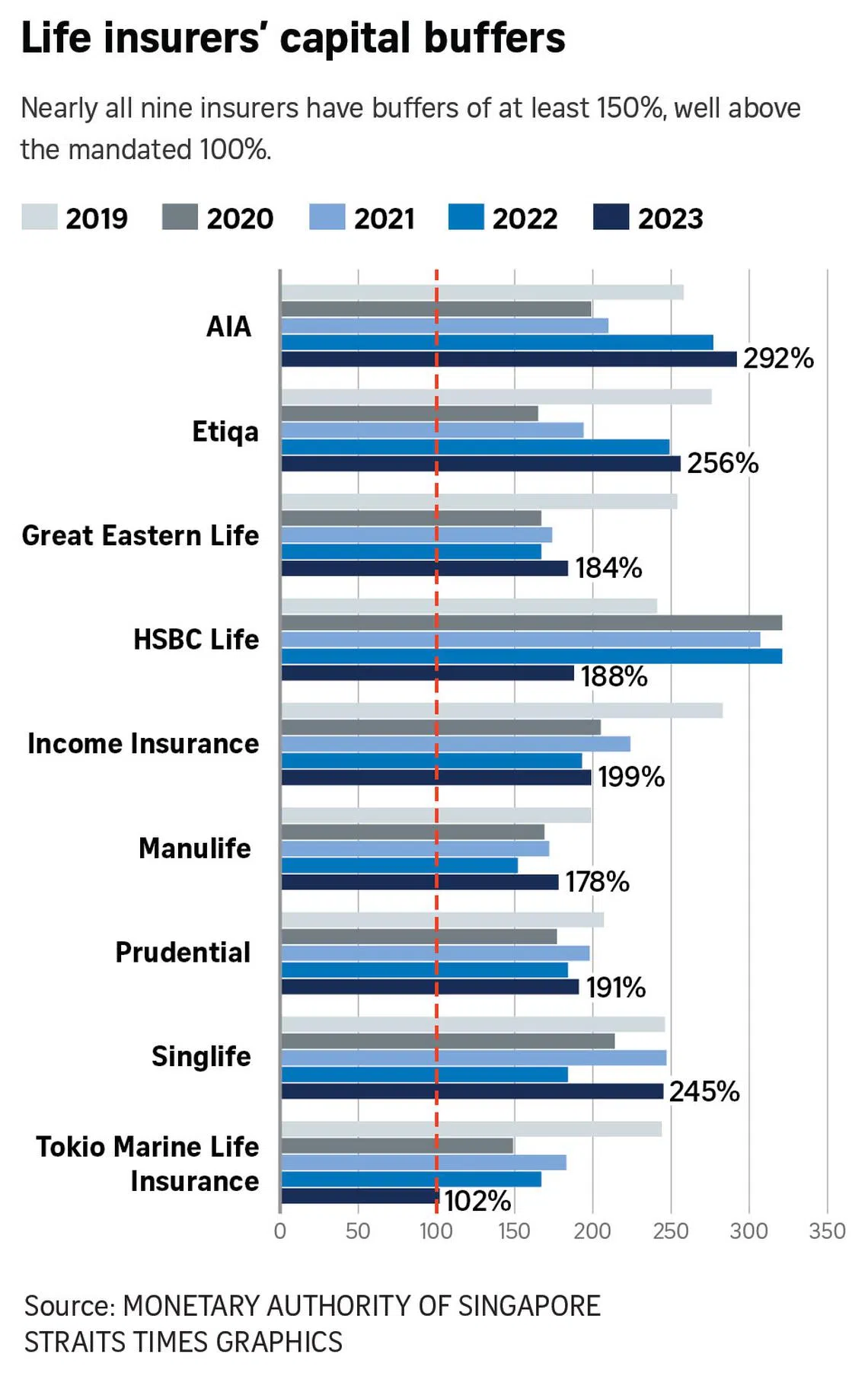Singapore life insurers have healthy capital buffers to withstand shocks
Sign up now: Get ST's newsletters delivered to your inbox

Singapore life insurers' capital buffers are expected to stay strong in the months ahead.
ST PHOTO: LIM YAOHUI
Follow topic:
SINGAPORE - The nine key life insurers in Singapore have healthy capital buffers to withstand sudden shocks and observers expect them to remain well capitalised in the months ahead.
Based on publicly available data, almost all nine hit a capital adequacy ratio (CAR) of at least 150 per cent, higher than the typical level of 100 per cent.
The nine insurers are AIA Singapore, Etiqa Insurance, Great Eastern Life, HSBC Life Singapore, Manulife Singapore, Income Insurance, Prudential Singapore, Singlife and Tokio Marine Life Insurance Singapore.
The stipulated minimum CAR requirement of 100 per cent is a way to ensure an insurer has enough capital buffer to withstand shocks.
Mr Danny Fischer, who is head of solutions for the Asia-Pacific at Mitsubishi UFJ Financial Group, said the CAR of Singapore life insurers remains strong and that it continues to be the case on a forward-looking basis.
“The sector is well capitalised and boards and management will continue to focus on strong capital solvency levels,” he said.
A look at the insurers’ returns showed that Tokio Marine Life’s CAR fell from 244 per cent in 2019 to 102 per cent in 2023.
The insurer said it adopted a renewed methodology in measuring capital adequacy, which was a key factor that led to the company revising its reported solvency ratios downwards, particularly in 2023.
Tokio Marine Life said it has taken various management actions, including capital injection in September 2024. “As a result, Tokio Marine Life’s CAR rose to 245 per cent as at the third quarter of 2024 (unaudited),” it said in a reply to The Straits Times’ queries.
It added: “We would like to reiterate (that) meeting our obligations to our customers and partners remains our utmost priority.”
Meanwhile, while Manulife’s CARs are well above the mandated level, it recorded the lowest CARs of between 152 per cent and 199 per cent in three of the five years from 2019 to 2023.
The insurer said it is in a position to meet its financial obligations and that it has a capital management policy to ensure it maintains a strong level of capital at country level to operate effectively and efficiently.
“At a global level, we are part of a global financial group with significant surplus capital,” Manulife added.
In the past, insurers would keep CAR above 120 per cent.
With MAS’ risk-based capital framework for insurers updated in 2020, some market observers said the practice is no longer relevant. The updated framework sets out tougher capital requirements so that insurers remain solvent in the event of shocks, and policyholders are protected.

When asked, Mr Fischer said every company’s board sets a target CAR, usually in a band, above the minimum statutory CAR of 100 per cent.
“For a systemically important insurer (SII), the capital requirements by the Monetary Authority of Singapore (MAS) are higher and hence their target range will be higher,” he said.
Four insurers here – AIA, Great Eastern, Income and Prudential – have been designated as SIIs as there would be substantial impact on Singapore’s financial system if they fell. The SII framework was published by MAS in 2023
Data showed that Great Eastern’s ratios in the five-year period – between 167 per cent and 254 per cent – were lower than that of the other three SIIs.
When asked, Great Eastern said its CAR has consistently been kept at a healthy level above MAS’ minimum requirements.
It added that the risk-based capital framework change in 2020 meant that the “2019 CAR was not on a comparable basis”.
Ms Jean Woo, office managing partner at law firm Ashurst Singapore, said an insurer’s CAR is stricter than those mandated for a bank.
“Insurance is the most capital intensive of all industries in a market. Building up market share or gaining access to the insurance sector will require substantial investments.
“Hence, most of the merger and acquisition activity in respect of insurance companies, like OCBC’s acquisition of Great Eastern and Allianz’s proposed acquisition of Income, are initiated by companies with substantial capital,” she noted.


